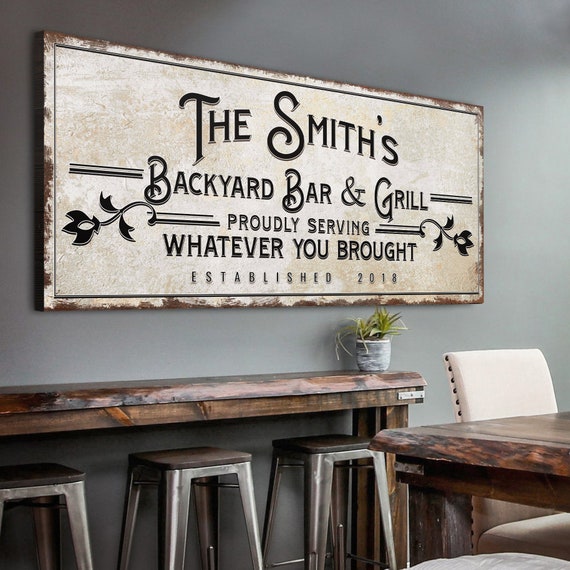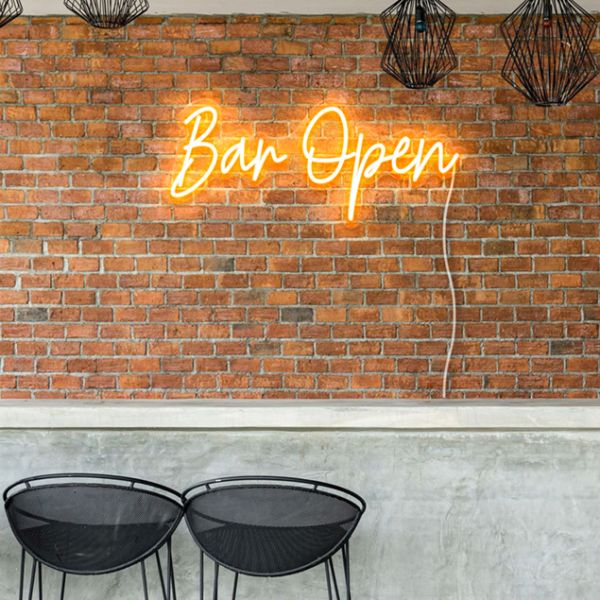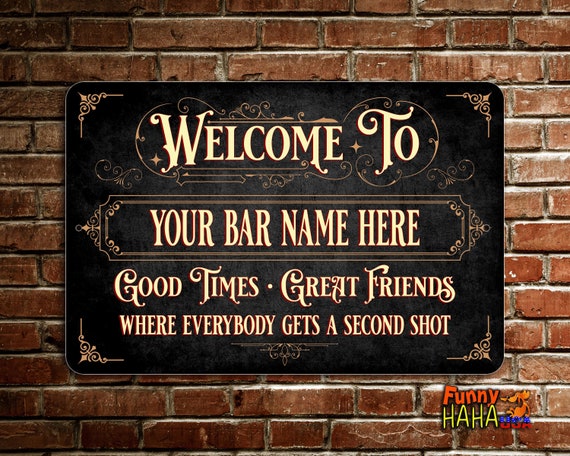New Advice To Picking Man Cave Signs
Wiki Article
What Is The Difference Between Bar Signs? Differ?
Location can make a big difference in the efficiency of bar signage. The style, design and location. are adapted to specific locations. Below is a breakdown of the different bar signs based on the location. Signs for the exterior
The purpose is to establish the bar and to draw in patrons.
Eye-catching, large, and often lit up at night.
Material: Materials such as neon, metals, LEDs and weather-resistant vinyl.
At the entrance, signs say: Name of bar, logo, marquee, etc.
2. Signs for Entrance
Begin by welcoming clients and providing initial information.
In most cases, with branding elements These features are usually easy to understand and enticing.
Materials: metal, wood or illuminated sign.
Examples: "Welcome' signs, schedules of operation or other announcements.
3. Interior wall signage
The purpose of this is to enhance the decoration, offer information, and create ambience.
Specifications: Available in different sizes and styles to match any interior decor.
Materials: Wood, metal, chalkboard, acrylic.
Examples include menu boards, decor signage and inspirational quotes.
4. Signs for Behind-the-Bar
Use: Highlight the most important aspects, such as the bar's name, its signature cocktails or specials.
Features: A prominent and well lit focal point.
Materials: Chalkboard and LEDs. Also, neon lights, digital displays.
Example: Digital menus, digital drinks specials boards and name signs for bars.
5. Signs for the ceiling and hanging
Use: Directional information or to improve the decoration.
Features: Suspended over the ceiling. Viewable from multiple angles.
Materials: Lightweight material like foam board, acrylic or metal.
Arrows can be used to direct people, decorative signs that hang from the ceiling or props with themes.
6. Tabletop Signs
The purpose is to provide information about the restaurant to patrons at tables.
The font is small and easy to read up close.
Materials: Wood, laminated papers, and acrylic.
Examples include drink menus and table numbers. Promotional cards, QR codes and stands for promotions.
7. Restroom Signs
Purpose: To clearly show the exact location of toilets.
Most often, they are accompanied by very clear symbols and text.
Materials: Metal, plastic, wood.
For example, male restroom signs for women and men.
8. Signs directing you
The purpose of this sign is to guide patrons to different areas within the bar.
Labels and arrows that are easily readable.
Materials: Metal, acrylic, wood.
Examples: Signs that lead to restrooms, exits or other seating areas.
9. Window Signs
Purpose: To attract people's attention and give information about the bar.
Features: Often visible from the outside, and often incorporate lighting.
Materials: Vinyl decals, neon, LED.
Examples: advertising signs, announcements of hours and other events.
10. Signs for events and promotions
Goal: Inform customers about special and seasonal promotional offerings.
Highlights: Always eye-catching and short-lived.
Materials: Foamboard, vinyl and chalkboard.
Examples include posters for events, promotional banners and chalkboard-themed specials.
Particular considerations pertaining to location
Visibility
Signs for Entrance and Exterior: Should be visible from a distance to draw in customers.
Signs for the bar's interior and behind-the-bar should be placed strategically to maximize impact and readability.
Durability
Exterior Signs. Use materials that are resistant to the weather.
Interior signs are a great choice as they can be created using a range of different materials.
Aesthetic Inclusion
Signs to indicate behind-the-bar and decorative signs: They are meant to complement and enhance the theme and interior design of the pub.
Instructional and informative signs The signs should be useful and blend into your decor.
Functionality
Bathroom and direction signs: They must be easy to read so that patrons can navigate the space easily.
Promotional and Event Signs They should be able to be changed or temporary in order to reflect current options.
Lighting
Signs for windows and exteriors: Illuminated to improve visibility at night.
Interior and Behind The Bar Signs could utilize lighting to enhance or create ambiance.
By tailoring bar signs' designs, layout and materials to their precise locations bar owners can enhance the functionality and aesthetic appeal of their establishment, thereby creating an atmosphere that's warm and harmonious. Follow the recommended gin bar sign for more info including personalised pub signs, pub sign hanging, hanging bar sign, home pub signs, the staying inn bar sign, hanging tavern sign, signs for garden bar, garden pub signs, personalised sign for bar, garden pub signs and more.

What Are The Differences Between Bar Signs In Terms Of Their Readability?
Bar signs are different in terms of their readability, dependent on various factors such as the font size, size, color contrast, lighting, and placement. These variables can affect the readability and effectiveness of bar signs. Font Choice
Specifications: the font used on the sign.
Readable Fonts: Choose fonts that are easy, sans-serif fonts, such as Arial or Helvetica. Or fonts with a simple serif, like Times New Roman.
Stylized Text: Decorative or script fonts, especially when seen from a distance or in low lighting conditions, can make it difficult to read the text.
Impact: Clear, legible fonts let patrons quickly and effortlessly comprehend the message.
2. Font Size
Specifications: The size of the text printed on the sign.
Large Fonts: These fonts are easier to read from afar, making them suitable for primary and exterior signs.
Small fonts can be used to create menus, signs and even tabletop signage.
Impact: The right size of font is essential for readability at various distances; larger text is more easy to read from a distance.
3. Color Contrast
Characteristics of the font: the difference in coloration between the text and the backdrop.
High Contrast refers to text with dark colors on white backgrounds or a light fonts on a black background.
Low Contrast: Text may become difficult to read if the colors of the background and text are similar (e.g. black on grey).
Impact: High contrast enhances readability and makes sure that the text stands out clearly.
4. Lighting
Signs' characteristics: How it is illuminated.
Well-lit signs: Signs that have front or back lighting enhance visibility in dim light conditions.
Poorly lit signs Poorly lit signs are often difficult to read at night or in dimly lit areas.
Impact: Proper illumination ensures the signs remain easily read and clearly visible in low-light environments.
5. Material and Finish
Signs can be distinguished by the kind of material and final appearance.
Matte Finish Matte Finish: Reduces reflections and glare, making text easier to read.
Glossy finishes: They can create glare when they are lit directly, and this can impact the ability of reading.
Impact: The correct material and finish can improve the readability of your display by reducing glare and reflections.
6. Text Layout
The sign's characteristics include text layout on the sign.
Clear Hierarchy: Use headings, subheadings and body texts to help organize your information.
Unorganized layout: A sign that is difficult to read can be cluttered with too much text, or feature a design that's overly complex.
Impact: A clear and well-organized layout allows customers to quickly comprehend and locate the details.
7. Viewing Distance
Characteristics: The distance from which the sign is supposed to be read.
For long distances: a larger fonts and high contrast are essential.
Short Distance: Smaller text is acceptable, but clarity and simplicity are still important.
Impact: Signs are designed to be read with the intended reading distance in mind.
8. Placement
Particularities: the physical location of the sign in the bar.
Placement is best at eye-level, in an area with ample light and is unobstructed.
Poor Placement: Up high and obstructed by objects or in dark areas.
Effectiveness: Properly placed signs will ensure that patrons can easily read and comprehend them.
Signs with Text that is Readable Examples
Exterior Signage
Characteristics: Text with high contrast (backlit neon,, etc.) placed in a prominent place.
Impact: Draws attention of customers, and can be observed from a distance.
Menu Boards
The characteristics of a chalkboard or backlit board include high-contrast clear headings, a large font for product names, and great lighting.
Impact: Simple for customers to read and decide on orders, enhancing their experience.
Directional Signs
Its characteristics are simple arrows, big text, and a high-contrast.
Impact Effect: Increases general flow, satisfaction, and the ability of patrons to navigate easily.
Promotional Signs
Specifications Highlights: Use bright, well-lit text and high contrast when promoting materials.
Impact: Effectively announces special events and promotions and encourages customer participation.
Factors Affecting Readability
Ambient lighting in bars and the general atmosphere of the bar could affect how well signage is read. Reading is improved in areas with ample lighting and a bright, well-lit.
Patron Movement - When there are a lot of people in bars, the signage must be easily read by patrons who move around. It is important to utilize large, high-contrast signs in these situations.
Regular updates: For signs that are frequently updated like daily specials, using formats that are readable with regular updates (e.g., digital chalkboards or displays) is important.
By paying attention to these elements bar owners can ensure they display signs that are not just visually appealing but also comprehendible, enhancing the overall customer experience. Take a look at the top look at this for pub signs for blog advice including indoor bar signs, pub signs personalised, garden bar sign personalised, personalised home pub sign, pub signs, personalised bar signs, a bar sign, pub signs for garden, make your own bar sign, the staying inn bar sign and more.

How Are Bar Signs Different From Regulations?
There are numerous rules and regulations applicable to bar signs. These are state, local and federal laws that ensure public safety and aesthetic standards. There are a few differentiators between bar signs as well as their regulations. Dimensions and placement regulations
Zoning laws: These regulations determine the size the distance, height and width of signs that are visible from roads, property lines or adjacent buildings.
Historic Districts - Signs may be restricted in the size, style, or materials to protect the historical characteristics of certain areas.
2. Illumination Restrictions
Light Pollution: In order to lessen light pollution it is possible to reduce the brightness, colour, and duration of illuminated signs.
Safety: Signs near roadways and other areas must be designed to avoid creating glare or distractions which could cause danger to motorists and pedestrians.
3. Signage content
Alcohol Advertising Certain jurisdictions have restrictions regarding alcohol advertising. They include a ban on certain imagery or content that entices minors, and encourages drinking to excess.
Health Warnings: Some laws might require that signage display warnings regarding the risks of drinking alcohol or smoking cigarettes.
4. Historic Preservation Regulations
Signs in historical districts must be in harmony with the architectural style or character of the area. This requires the approval of preservation boards.
Material and Design: Signs that are historic in nature may have limitations on the materials used as well as the design and color scheme.
5. Sign Permitting Process
Permit requirements: Prior to installing or changing the signs bars are required to obtain permits. This might require the submission of plans, payment of fees and obtaining approval from local authorities.
Code Compliance: Signs should conform to building codes as well as fire safety regulations and accessibility standards to ensure the safety of the public and accessibility for individuals with disabilities.
6. Repair and removal of signs
Maintenance Requirements Bar owners are accountable to keep their signs in good condition, ensuring they are solid and safe from hazards, and compliant to the rules and regulations.
Abandoned Signs: Regulations may govern the removal of abandoned and dilapidated signage to avoid blight while keeping the appearance of the surrounding area.
7. Digital Signage Regulations
Content Restrictions: Laws can restrict the content that is displayed on digital signage, for example by prohibiting flashing lights and graphic images that are offensive.
Limitations on the Operational Signs to reduce visual clutter, regulations may limit the intensity of digital signage, their movement or their frequency of changes.
8. Enforcement and Penalties
Inspections Local authorities conduct periodic inspections in order to verify that signs are in compliance with regulations. The issue of citations is for infractions.
Penalties: Penalties if you do not follow the rules may include fines, citations for removal or modify signs, or legal action.
9. Sign Process
Variance applications bar owners who wish to deviate their signage from the regulations can do so by requesting a variance. The reason for the variance must be given, and any adverse effects on the public's security or appearance should be mitigated.
Public input: Variations may require public meetings or input from the local community, owners of property living in close proximity, or business groups.
10. Community Engagement and Input
Public Consultation: Certain authorities consult with their communities in order to create regulations for signage. This could be accomplished via public meetings, surveys or stakeholder consultations.
Community Benefits: Sign regulations could include provisions to promote local businesses, or to revitalize the neighborhood.
By adhering to and understanding the guidelines for signs, bar owners can be sure that their signage adds visual appeal to their establishments, are beneficial to the local community, and meet legal standards. This reduces the risks of fines, legal disputes or penalties. See the most popular personalised bar signs recommendations for more tips including personalised home pub sign, the staying inn pub sign, bar sign hanging, make a pub sign, personalised cocktail bar sign, hanging pub signs for sale, bar sign hanging, gin bar sign, bar signs for home bar, large personalised bar signs and more.
